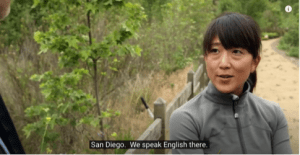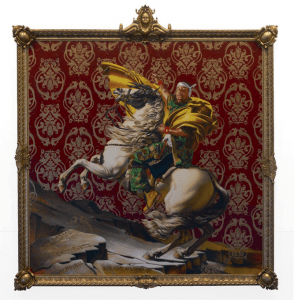Where are you from? Thoughts on identity, Israeli poetry, and coronavirus
by Naomi Kass ’20
Reading the Israeli poet Vaan Nguyen’s poem “Culture Stain” immediately brought me back to my SOCI 101 class last fall where in our week on race and racism we were shown this YouTube video, “Where are you from?” The inept “cross-cultural” interaction presented in this video is particularly relevant not only to Vaan Nguyen, who, like the woman in this video, feels and is entirely of one culture although she appears to others to belong to another, but also to the current uptick in anti-Asian racism and xenophobia as a result of COVID-19.
As the daughter of Vietnamese refugees granted asylum in Israel, Nguyen writes in the poem about this uneasiness about belonging:
A rosy sun sets
on a musical Monetbach lake in your eyes—
When we hold each other
you’ll ask where I came from. I’ll say
I came from this rot.
Where did I come from, you’re asking,
I mean, parents?
In class, we discussed how one’s physical appearance can betray a cultural heritage that you do not feel directly connected to (i.e., Korean, Vietnamese), which can have the potential for both positive and negative ramifications while navigating your “true” cultural milieu (i.e., America, Israel). COVID-19 has especially increased the likelihood that bearing a “culture stain” will result in negative outcomes, such as in the imagined relationship Vaan Nguyen presents in “Culture Stain” and in the interaction between the “Korean-American” woman and “British-American” man in “Where are you from?”
The way Vaan Nguyen views her Vietnamese and Israeli heritage in “Culture Stain” is not unlike how the “Korean-American” woman in “Where are you from?” navigates her own identity. More broadly, the universal issues surrounding the ups and downs of being forced to navigate one’s cultural stain while living as an ethnic minority reveals similarities between American and Israeli culture brought about by their uniquely multi-cultural and multi-ethnic societies. Although many other nations are also considered melting-pots, what bridges the experience of multi-culturalism in America and Israel is how writers, poets, and artists have used their mediums to react to those shared experiences.
The poetic and literary goal of Vaan Nguyen’s “Three Snapshots of Paris” is highly resonant with the way African American artists and writers have attempted to voice their previously suppressed identities by reclaiming the European objects of their oppression. One notable artist is Kehinde Wiley, who, among many other examples, recreated David’s famous portrait of Napoleon on horseback to reflect his Nigerian and African American heritage through the use of African-inspired symbology, colors, and textiles, as well as references to black American hip hop culture and African militarism in the depiction of his reimagined Napoleon.
The colonizing presence of France was not limited to Africa but was also the major colonial power in Vietnam. With her humorous, debasing, and grotesque depiction of Paris in three “snapshots” a la a nineteenth century Parisian flaneur, Vaan Nguyen employs a European, and particularly French, sensibility for observing the peculiarities of urban life to reclaim her cultural power by presenting a non-normative view of the historically and culturally vaunted city:
a mother screams as a step-child
dips his hand into the fountain.
Someone’s smoking a joint….
August on
the promenade of the Champs-Élysées
taps the womb.
I threw up cigarettes on a man….
Rain baked with Grand Marnier
gives off notes of onion and pigeon shit.
In “Where are you from?” the “Korean American” woman takes a similar, humorous approach in order to reclaim and reaffirm her true self in reaction to those people who style themselves as gate-keepers of “real” American identity. The woman in the video claims her identity by highlighting the absurdity of identity itself. While conceptions of identity are ever evolving (an Israeli person can be ethnically Vietnamese), culture stains remain stagnant (retaining the appearance of a Vietnamese woman despite being Israeli) and often work against the forces of rapidly changing new and diverse identity formations. The woman in the video accomplishes her almost paradoxical task—having to reclaim identity by revealing its own contradictions, paradoxes, and absurdities—by flipping the narrative on the prying and over-curious white jogger. Ironically, it is the man’s own British heritage, and not the woman’s genetic links to Korea, that poses the greatest threat (at least historically speaking) to specifically American values of democracy and liberty that are so bound up in the construction of American identity.
A similar irony pervades Israeli society, and particularly Israeli literary culture. While Ashkenazi culture was, and to some extent still is, considered the ideal framework upon which to construct a new Israeli identity and society, the ideals Jewish Israelis have attempted to emulate are taken from a cultural context in which those same individuals were despised and devalued. An essentialist argument would concede that Mizrahi, not Ashkenazi, culture is most in line with the “purest” and most “original” form of Jewish life. However, as we have experienced throughout history, and particularly Jewish history, trying to pinpoint and embody the purest form of identity—whether that is “real” Jewish/Israeli identity or even Aryan identity—is never a good idea. Just like Vaan Nguyen, the woman in the video, and Kehinde Wiley make clear, the farce of identity is that it can ever be perceived by someone other than oneself—the word itself implies an individual construction that reflects the multifaceted aspects of that person formulating and defining that specific identity.


